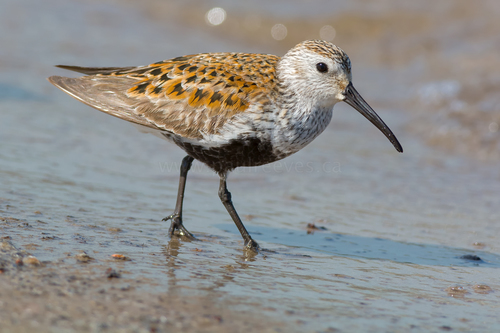
Dunlin
The Dunlin (*Calidris alpina*) is a small, highly migratory wader known for its remarkable long-distance flights and distinctive breeding plumage. It plays a crucial role in coastal and wetland ecosystems, serving as both predator and prey. Dunlins are also indicators of environmental health, as their populations are sensitive to habitat changes and pollution. Culturally, they are often featured in coastal folklore and are a favorite subject for birdwatchers, particularly during their impressive winter murmurations.
17-21 cm
Length
32-36 cm
Wingspan
Least Concern
Conservation Status
Distribution
The Dunlin has a circumpolar breeding distribution in the Arctic and subarctic regions of North America, Europe, and Asia. During winter, it migrates south to coastal areas across a wide range, including the coasts of North America, Europe, Africa, the Middle East, and Asia. They utilize a range of coastal altitudes, and can be found inland during migration.
Lifespan
The average lifespan in the wild is around 5-10 years, but some individuals have been recorded living over 20 years.
Dunlin's Habitat
Habitat Types
Coastal mudflats, Salt marshes, Estuaries, Tundra, Beaches, Inland wetlands (during migration)
Climate Zones
Arctic, Subarctic, Temperate, Tropical (during migration and wintering)
Adaptations
Dunlins have slightly webbed feet, which aid in walking on soft mud. Their bills are sensitive, allowing them to probe for prey in the mud by feel. They also possess physiological adaptations for dealing with the salinity of coastal environments.
Variations
Several subspecies of Dunlin are recognized, differing in size, bill length, and plumage details. These subspecies often have distinct breeding and wintering ranges. Examples include *C. a. alpina* (Northern Europe and Siberia), *C. a. hudsonia* (North America), and *C. a. sakhalina* (Eastern Asia).
Appearance
Breeding Plumage
Breeding plumage is characterized by a distinctive black belly patch, reddish-brown back, and streaked breast. Non-breeding plumage is much duller, with a grayish-brown back and white belly.
Seasonal Feather Changes
The transition between breeding and non-breeding plumage occurs through molting, with a complete molt after breeding and a partial molt before breeding.
Sex Based Plumage Differences
While both sexes exhibit the black belly patch in breeding plumage, males tend to have more intensely colored reddish backs.
Notable Features
Slightly downcurved bill, Black belly patch (breeding plumage), White wing stripe visible in flight
Diet and Feeding
Primary Foods
Invertebrates, Marine worms, Crustaceans, Mollusks, Insects, Insect larvae, Small seeds (occasionally)
Foraging Behavior
Dunlins are tactile feeders, probing the mud with their bills to locate prey. They often feed in large flocks, moving systematically across mudflats and shorelines. They may also visually pick prey from the surface.
Specializations
Their bill has a sensitive tip that helps detect prey buried in the substrate. The slightly downcurved shape aids in probing.
Seasonal Diet Variations
During the breeding season, their diet shifts to include more insects and insect larvae found on the tundra. In winter, they rely more on marine invertebrates found in coastal habitats.
Behavior
Social Structure
Highly gregarious, especially outside the breeding season. They form large flocks, sometimes numbering in the thousands, during migration and wintering. Breeding pairs are territorial.
Communication
Variety of calls, including a distinctive 'kree' flight call, Trilling songs during breeding displays, Visual displays, such as wing raising
Migration
Dunlins are long-distance migrants. Some populations undertake impressive journeys between Arctic breeding grounds and wintering areas thousands of kilometers away. They navigate using a combination of celestial cues, the Earth's magnetic field, and landmarks.
Territorial or Group Behaviors
During the breeding season, pairs defend territories around their nests. Outside of breeding, they are highly social and form large, cohesive flocks, often exhibiting synchronized flight maneuvers (murmurations).
Conservation
Threats
Habitat loss and degradation (coastal development, pollution), Climate change (sea level rise, changes in Arctic breeding habitat), Disturbance at stopover and wintering sites, Hunting (in some regions)
Protection Programs
International agreements like the Ramsar Convention on Wetlands, Migratory bird treaties, Designation of protected areas (e.g., national wildlife refuges)
Local National Laws
Protected under various national laws, such as the Migratory Bird Treaty Act in the United States and the Birds Directive in the European Union.
Population Trend
Overall, the global population trend is considered stable, but some populations are declining.
Population Estimates
The global population is estimated to be in the millions, but precise numbers are difficult to obtain due to the species' wide range and migratory nature.
Interesting Facts
Dunlins can fly at speeds of up to 50 mph (80 km/h).
This allows them to cover long distances during migration.
They are known for their spectacular murmurations.
Large flocks perform synchronized aerial displays, creating mesmerizing patterns in the sky, thought to be a defense against predators.
The black belly patch of breeding plumage is unique to each individual.
Like a fingerprint, it can be used to identify individual birds.
Faqs about Dunlin
What is the difference between a Dunlin and a sandpiper?
Dunlin is a *type* of sandpiper. The term 'sandpiper' refers to a large group of shorebirds within the family Scolopacidae, and the Dunlin (Calidris alpina) is one species within that family.
Where can I see Dunlins?
Dunlins can be seen in coastal areas around the world, particularly during migration and winter. Look for them on mudflats, beaches, and estuaries. During the breeding season, they are found in Arctic and subarctic regions.
Are Dunlins endangered?
Dunlins are currently classified as 'Least Concern' by the IUCN, meaning they are not considered globally threatened. However, some populations are facing declines due to habitat loss and other threats.
Copyright @ Nature Style Limited. All Rights Reserved.
 English
English